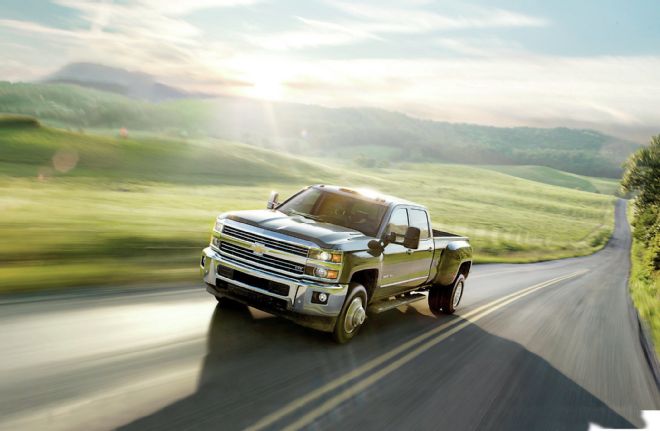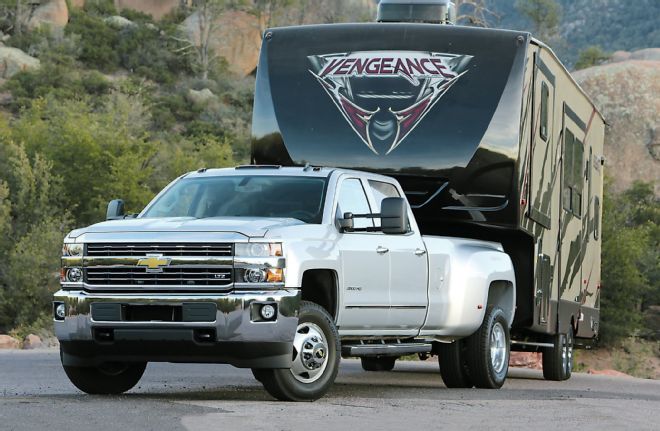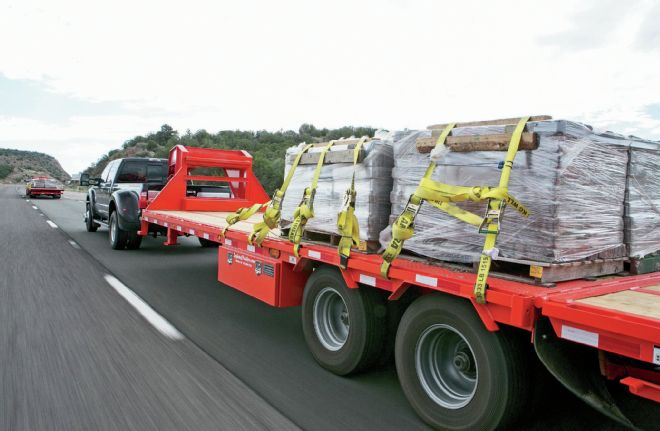Maximum trailer tow ratings have been a bit of a mystery over the years. Manufacturers each had their own somewhat secret ways of determining how much weight their diesel vehicles could safely tow, but there was no universal testing standard for all of them to follow.
In response to the confusion that resulted when buyers wanted to compare maximum tow ratings, the Society of Automotive Engineers (SAE) has developed the J2807 set of recommended practices. The tow test procedures designed by the big brains at the SAE consist of a series of rigorous real-world challenges to determine the Gross Combined Weight Rating (GCWR) of a vehicle and trailer combination.
The resulting GCWR is then used to calculate a maximum trailer weight rating, and that can be used to compare with any other truck that’s also tested using the J2807 standards. In addition to very detailed requirements for the design of the trailer, including the structure, chassis, ballast, and even the exact brand, model, and size of the trailer tires, the J2807 lays out performance tests required for a truck and trailer combination to meet the new towing standard. Once J2807 data is in use by all manufacturers, buyers should have a much better idea of the true towing capabilities of modern diesel trucks. Since all of the Big Three are in the process of switching to the SAE standards, buyers should now be able to cross-shop trucks from different brands with more confidence.
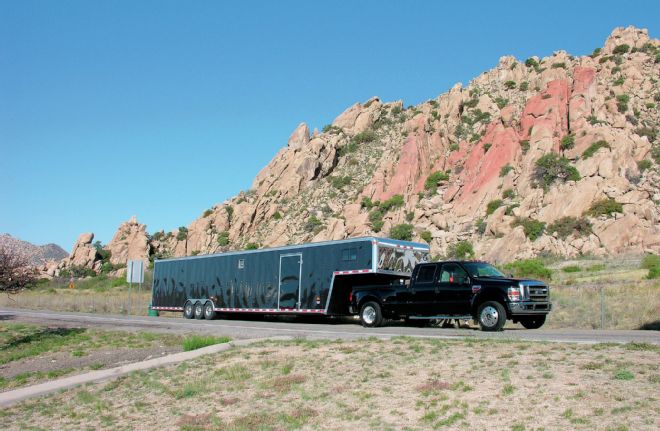
| Ford Super Duty Towing Large 5th Wheel Trailer
Fully Equipped
The J2807 “Test Tow-Vehicle Selection” requirements have some wiggle room in the ratings assigned to a particular configuration, but the allowances favor the customer. The rules require that a tow vehicle “shall be equipped with the propulsion system or powertrain and driveline (engine, transmission, axle ratio, tire size, etc.) and cooling package to produce the GCWR under test.” If there is more than one tire size or final drive ratio available for a manufacturer’s truck model rated with the same GCWR, the combination with the lowest numerical axle ratio is the one that will be tested.
The SAE J2807 test procedures are designed to level the playing field in trailer tow ratings for all vehicles model year 2013 or later. The foreword reads:
“Light truck, minivan, sport utility, and crossover vehicles represent a significant portion of the North American vehicle mix, and trailering usage of these vehicles has increased. Heavier-duty models, approaching medium-duty trucks and often intended for trailering, have become more popular as well. Some passenger cars are also rated to tow trailers. For many vehicles, trailer weight rating may be a major marketing point.
As trailer weight ratings have increased, engine characteristics like horsepower and torque, thermal performance and driveline durability are no longer the only significant factors in determining trailering capability. Combination vehicle dynamics and tow-vehicle hitch/attachment structure have gained in significance.
This document defines procedures and requirements to determine Gross Combination Weight Rating (GCWR) andcalculate corresponding Trailer Weight Rating (TWR) for any tow vehicle. These procedures will establish consistent rating requirements and processes so end users (customers) can reasonably compare similar class models in terms of trailering ability.”
If there is “optional cooling content” that’s not required for the stated GCWR, the truck will be tested without those aids. In addition to a vehicle’s base curb weight, the “Tow Vehicle Total Weight” (TVTW) for testing for ¾- and 1-ton trucks allocates 150 pounds for the driver, 150 pounds for a passenger, the weight of all tow package equipment, and 100 pounds of optional equipment (hitch ball, weight distribution bars, and such) split evenly between the front and rear axles. The chassis content required (suspension, steering, brakes, and so on) is “immaterial to this section as long as it does not affect propulsion/powertrain selection or final drive ratio.” This became a bit of a loophole when manufacturers passed the test using vehicles “equipped” with bumper and spare tire delete options meant for work trucks, but after that became public, everyone seemed to straighten up their acts and stopped taking advantage of this non-requirement.
3…2…1… Launch!
To test the ability of a truck and trailer to get moving from a dead stop in practically any situation, the SAE came up with a “Launch on Grade” test. To pass, while on an incredibly steep 12 percent grade, a truck must be able to launch and travel 16 feet (5 meters) uphill, five times in a row, in 5 minutes or less. Then, the truck and trailer has to be able to complete the same test while launching up a 12 percent grade in Reverse. Any amount of throttle input is allowed, and the clutch in manual-equipped trucks can be used however it’s needed to complete the test.

| The Davis Dam Grade Arizona State Route 68 is a stretch of road that starts in the Davis Dam area of the Colorado River, close to Laughlin, Nevada, and Bullhead City, Arizona, with an elevation of just about 550 feet. This stretch of highway travels through the Black Mountains and climbs to Highway 93 near Kingman, Arizona. The section used for the SAE J2807 Highway Gradeability Test starts just past the intersection of SR 68 and Highway 95 outside of Laughlin and climbs to more than 3,500 feet in just 11.4 miles.
Flat-Out Acceleration
Three tests are used to determine if a truck/trailer combination has sufficient acceleration on flat sections of road. One is a test that measures the 0-to-30-mph time, with single-rear-wheel trucks needing to reach that speed in 12.0 seconds, while dual-rear-wheel models get 14.0 seconds. There is also a 0-to-60-mph acceleration test that allows SRW trucks 30.0 seconds to reach that highway speed while DRW models get 35.0 seconds. To measure passing capability, the 40-to-60-mph time of single-rear-wheel trucks must be 18.0 seconds or less, and dual-rear-wheel trucks are allowed up to 21.0 seconds.
Making the Grade
To simulate some of the toughest conditions a truck and trailer combination will face, the J2807 “Highway Gradeability” tests take place on a well-known stretch of Arizona highway, the 11.4-mile-long Davis Dam Grade. If trucks are not tested on this specific stretch of steep road, they can be run in a simulation using a “climactic” wind tunnel. Ambient temperature plays a significant role in this test with a minimum temperature of 100 degrees required at the base of the grade. In addition to a hot climate outside the truck, the test requires the air conditioning system to be set at maximum cold, with outside air selected (not recirculating) and the fan running at full blower speed.
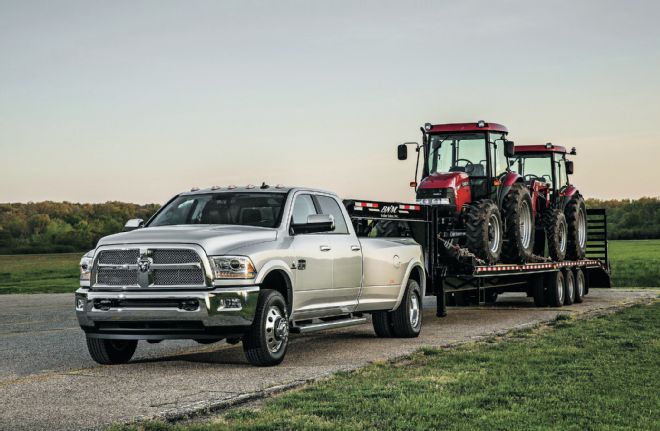
| ’15 Ram 3500
Once those criteria are met, the evaluation can begin on the famous stretch of SR 68 between Bullhead City and Golden Valley, Arizona. To pass this test, a truck-and-trailer combination must be able to drive at 40 mph (35 mph for dualies) and never drop below that speed until the end of the test segment at the peak of Union Pass. Testdrivers are allowed to go faster than the minimum speed requirement in the sections of the grade where posted speed limits are 55 mph and 65 mph, but there are other requirements the vehicle must still meet. Under “drivetrain system performance,” the J2807 standard requires there be no component failures, along with no “check engine” lights or any other alerts or warnings for the driver. The “cooling system performance” requirement also requires zero part failures, no error codes, no driver warnings of any other kind, and no loss of coolant fluid during the test.
Total Control
The truck-and-trailer “Combination Handling Requirements” of J2807 specify minimum performance for understeer and trailer sway response. The tests are designed to determine the limits of the weight carrying, weight distributing, and stability of a fifth-wheel/gooseneck trailer, with the combo at its maximum GCWR. Understeer (the opposite of fishtailing) is measured at three different levels of Front Axle Load Restoration (FALR), which is a calculation of how much the load on the front axle changes. It can sound complicated, but the procedures are designed so you can be assured your truck will not be steered by the weight of the trailer under typical driving conditions even while pulling the maximum tow weight. For example, with a fifth-wheel or gooseneck hitch, the truck/trailer combination is allowed 0 degrees per g of understeer when there are 0.4 g or less of lateral acceleration and an FALR of 0 percent. In addition to the understeer tests, there is a measurement for the maximum sway damping that requires the trailer to move at a ratio of 0.10 or less at 62.1 mph (100 km/h).
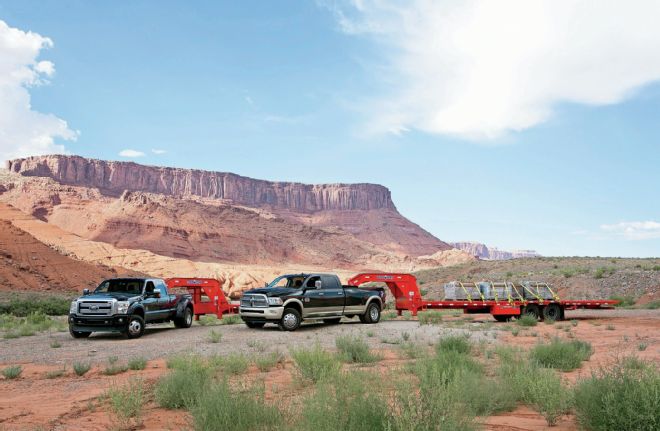
| Ford F 350 And Ram 3500 Towing
Stop It!
The J2807 standards also have requirements for the braking performance of the truck-and-trailer combination at its maximum GCWR. Combos with a maximum tow rating of more than 3,000 pounds are required to stop completely from 20 mph in 80 feet or less. During this stop test, the trailer must remain within an 11.5-foot-wide lane throughout the entire stop. In addition to the active testing, the parking brake must be able to hold the truck and trailer firmly in place both upward and downward on a 12 percent grade when it is at the maximum GCWR.
The Max Math
Once testing has been completed and a truck model meets all of the criteria, the basic calculation for the SAE maximum Tow Weight Rating is: TWR = GCWR – TVTW. By subtracting the total weight of the tow vehicle (the TVTW includes the weight of the driver, passenger, and additional equipment) from the tested GCWR, the result is the SAE J2807-compliant Tow Weight Rating. This rating is the number buyers can use to cross-shop against other J2807-compliant trucks, and they can rest assured they all had to meet the same requirements—something they’ve never been able to truly do before these standards were created.
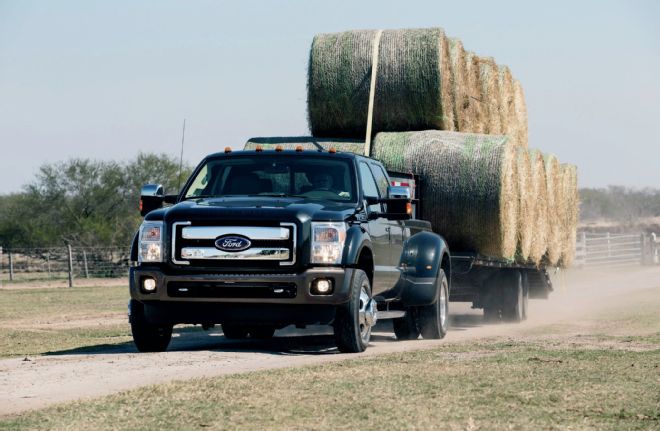
| ’15 Ford F-350
SAE J2807 Requirements
These are some of the main requirements of the SAE J2807 “Surface Vehicle Recommended Practice,” which lists the “Performance Requirements for Determining Tow-Vehicle Gross Combination Weight Rating and Trailer Weight Rating.” The document detailing the test procedures and requirements is 27 pages long and includes tons of details we don’t have room to list. Here are some of the highlights.
Tow Vehicle Propulsion Requirements
Tow Vehicle Propulsion Requirements
Level Road Acceleration
Performance Attribute
Performance Metric
Requirement
0-30 mph
12.0 seconds single-rear-wheel/14.0 seconds dual-rear-wheel
Level Road Acceleration
0-60 mph
30.0 seconds single-rear-wheel/35.0 seconds dual-rear-wheel
Level Road Acceleration
40-60 mph
18.0 seconds single-rear-wheel/21.0 seconds dual-rear-wheel
Launch on Grade
12% grade, forward direction
Five launches to 5.0 meters (16 feet) in 5 minutes
Launch on Grade
12% grade, reverse direction
Five launches to 5.0 meters (16 feet) in 5 minutes
Highway Gradeability
Minimum speed on grade (Davis Dam)
40 mph single-rear-wheel/35 mph dual-rear-wheel
Highway Gradeability
Drivetrain system performance
No component failures, no diagnostic codes that alert the operator, no customer warnings
Highway Gradeability
Cooling system performance
No component failures, no diagnostic codes that alert the operator to take service or driving action, no customer warnings, no fluid loss
Combination Handling Requirements
Performance Attribute
Performance Metric
Requirement
Tow vehicle understeer
Understeer at lateral acceleration ≤0.3 g at 100% FALR
<0 degree/g
Tow vehicle understeer
Understeer at lateral acceleration ≤0.4 g at 50% FALR
0 degree/g
Tow vehicle understeer
Understeer at lateral acceleration ≤0.4 g for weight carrying TWR (0% FALR) and for fifth-wheel and/or gooseneck TWR
0 degree/g
Trailer Sway Response
Trailer sway damping ratio
0.10 at 100 km/h (62.1 mph)
Combination Braking Requirements
Performance Attribute
Performance Metric
Requirement
Combination Stability
Deviation within lane
Remain within a 3.5-meter-wide (11.5 feet) lane throughout stop
Combination Stopping Distance
Stopping distance 20-0 mph for TWR 3,000 pounds
≤35 feet, except ≤45 feet at any TWR above the tow vehicle’s unbraked TWR
Combination Stopping Distance
Stopping distance 20-0 mph for TWR 3,000 pounds
≤80 feet
Park Brake Performance
Hold on grade
12% grade at GCWR (upward and downward)
 | Ford Super Duty Towing Large 5th Wheel Trailer
Fully Equipped
| Ford Super Duty Towing Large 5th Wheel Trailer
Fully Equipped


 | The Davis Dam Grade Arizona State Route 68 is a stretch of road that starts in the Davis Dam area of the Colorado River, close to Laughlin, Nevada, and Bullhead City, Arizona, with an elevation of just about 550 feet. This stretch of highway travels through the Black Mountains and climbs to Highway 93 near Kingman, Arizona. The section used for the SAE J2807 Highway Gradeability Test starts just past the intersection of SR 68 and Highway 95 outside of Laughlin and climbs to more than 3,500 feet in just 11.4 miles.
| The Davis Dam Grade Arizona State Route 68 is a stretch of road that starts in the Davis Dam area of the Colorado River, close to Laughlin, Nevada, and Bullhead City, Arizona, with an elevation of just about 550 feet. This stretch of highway travels through the Black Mountains and climbs to Highway 93 near Kingman, Arizona. The section used for the SAE J2807 Highway Gradeability Test starts just past the intersection of SR 68 and Highway 95 outside of Laughlin and climbs to more than 3,500 feet in just 11.4 miles.


 | ’15 Ram 3500
Once those criteria are met, the evaluation can begin on the famous stretch of SR 68 between Bullhead City and Golden Valley, Arizona. To pass this test, a truck-and-trailer combination must be able to drive at 40 mph (35 mph for dualies) and never drop below that speed until the end of the test segment at the peak of Union Pass. Testdrivers are allowed to go faster than the minimum speed requirement in the sections of the grade where posted speed limits are 55 mph and 65 mph, but there are other requirements the vehicle must still meet. Under “drivetrain system performance,” the J2807 standard requires there be no component failures, along with no “check engine” lights or any other alerts or warnings for the driver. The “cooling system performance” requirement also requires zero part failures, no error codes, no driver warnings of any other kind, and no loss of coolant fluid during the test.
Total Control
| ’15 Ram 3500
Once those criteria are met, the evaluation can begin on the famous stretch of SR 68 between Bullhead City and Golden Valley, Arizona. To pass this test, a truck-and-trailer combination must be able to drive at 40 mph (35 mph for dualies) and never drop below that speed until the end of the test segment at the peak of Union Pass. Testdrivers are allowed to go faster than the minimum speed requirement in the sections of the grade where posted speed limits are 55 mph and 65 mph, but there are other requirements the vehicle must still meet. Under “drivetrain system performance,” the J2807 standard requires there be no component failures, along with no “check engine” lights or any other alerts or warnings for the driver. The “cooling system performance” requirement also requires zero part failures, no error codes, no driver warnings of any other kind, and no loss of coolant fluid during the test.
Total Control | Ford F 350 And Ram 3500 Towing
Stop It!
| Ford F 350 And Ram 3500 Towing
Stop It! | ’15 Ford F-350
SAE J2807 Requirements
| ’15 Ford F-350
SAE J2807 Requirements